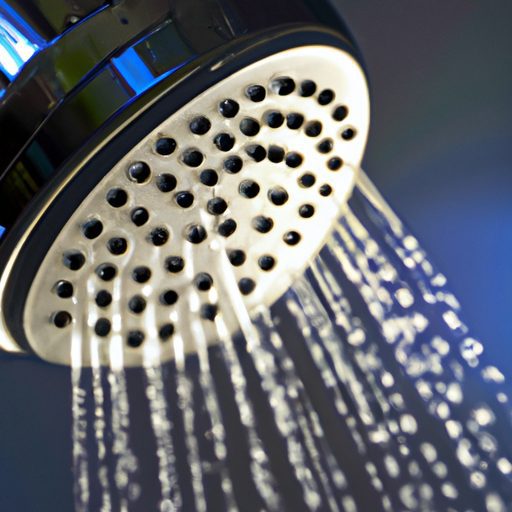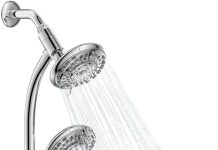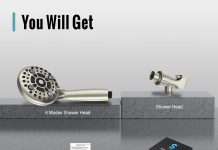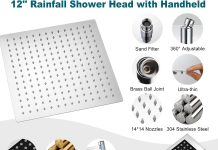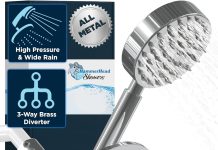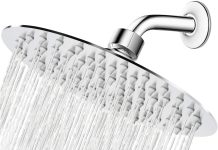Are you tired of standing under a weak trickle of water during your morning shower? If you’re wondering how to increase the water flow to your shower head, you’re in the right place. In this article, we will explore some simple and effective tips to help you boost the water flow in your shower and enjoy a more invigorating and satisfying bathing experience. So, say goodbye to lackluster showers and get ready to turn up the water pressure!
Table of Contents
Checking the Water Pressure
Test the water pressure
When it comes to enhancing the water flow to your shower head, the first step is to check the water pressure in your home. Inadequate water pressure can result in a weak flow, making your shower experience less enjoyable. To test the water pressure, you can use a pressure gauge specifically designed for this purpose. Simply attach the gauge to an outdoor faucet and turn on the water. The gauge will give you a reading in pounds per square inch (PSI), indicating the pressure level.
Inspect the water supply valve
Another important factor to consider when trying to increase water flow is the condition of your water supply valve. Sometimes, the valve may not be fully open, leading to reduced water pressure. Ensure that the water supply valve, usually located near your water meter, is fully open. If it is partially closed, simply turn the valve counterclockwise to open it completely.
Clean or replace the water filter
A clogged or dirty water filter can also contribute to low water pressure. Water filters are designed to trap debris and sediment, preventing them from flowing through your plumbing system. Over time, these filters can become clogged, restricting the water flow. If you have a water filter in your home, check it regularly and clean or replace it as needed. This simple task can significantly improve water pressure in your shower.
Inspecting the Shower Head
Remove and clean the shower head
One common cause of decreased water flow in the shower is a clogged shower head. Mineral deposits from hard water can accumulate over time, blocking the tiny openings that allow water to flow. To address this issue, you can remove the shower head and give it a thorough cleaning. Soak it in a mixture of warm water and vinegar to dissolve any mineral buildup. Use a toothbrush or a small brush to scrub away any remaining debris. Once cleaned, reinstall the shower head and enjoy the improved water flow.
Check for mineral buildup
In addition to cleaning the shower head, it’s essential to inspect it for any mineral buildup. Hard water often contains minerals like calcium and magnesium, which can accumulate on the shower head and restrict water flow. If you notice any white or chalky residue on the surface of the shower head, it’s a good indication of mineral buildup. Regularly checking for and removing these deposits will help maintain optimal water flow to your shower.
Remove any obstructions
Sometimes, foreign objects or debris can find their way into the shower head, obstructing the water flow. Inspect the shower head carefully and remove any visible obstructions such as dirt, hair, or small objects. Use a toothpick or pin to gently dislodge anything that may be blocking the water flow. Taking these steps to clear any obstructions will ensure that water can flow freely, giving you a satisfying shower experience.
Adjusting the Flow Regulator
Locate the flow regulator
Flow regulators are commonly installed in shower heads to limit water flow and promote water conservation. While they serve a useful purpose, they can also restrict the water flow if set too low. To increase the water flow in your shower, you may need to locate and adjust or remove the flow regulator. The flow regulator is typically found inside the shower head or connected to the shower hose.
Remove or adjust the flow restrictor
Once you have located the flow regulator, you can either remove it completely or adjust its settings. If you choose to remove it, gently unscrew the shower head and locate the flow restrictor. It is often a small plastic piece with holes. Simply unscrew or pull it out, depending on the design of your shower head. If you prefer to keep the flow regulator but want to increase the water flow, you can adjust its settings by rotating or removing certain parts. Experiment with different adjustments until you find the desired water flow.
Installing a New Shower Head
Choose a high-flow shower head
If you have tried all the previous methods and still not satisfied with the water flow in your shower, it might be time to install a new shower head. When selecting a new shower head, consider opting for a high-flow model. These shower heads are specifically designed to optimize water flow, providing a more invigorating shower experience.
Select the appropriate design
Apart from finding a high-flow shower head, it’s crucial to choose a design that suits your preferences and bathroom decor. There are various types of shower heads available, including fixed shower heads, handheld shower heads, rain shower heads, and even dual shower heads. Consider factors such as water pressure, spray pattern, and ease of use when selecting the best shower head for your needs.
Install the new shower head
Once you have chosen your new shower head, it’s time to install it. Start by removing the old shower head. Use an adjustable wrench or pliers to loosen the connection between the shower arm and the old shower head. Once removed, clean the shower arm threads with a cloth to ensure a smooth installation. Next, attach the new shower head to the shower arm and tighten it securely. Be careful not to overtighten, as it may damage the new shower head or cause leaks. Once installed, turn on the water to test the water flow. Enjoy your revitalized shower experience with the new high-flow shower head.
Replacing the Shower Valve
Identify the type of shower valve
If you have exhausted all other options and still cannot achieve the desired water flow, it might be necessary to replace the shower valve. To do this, you need to identify the type of valve currently installed in your shower. Common types include ball valves, cartridge valves, and compression valves. Knowing the specific type will help you find a compatible replacement.
Purchase a compatible replacement
Once you have identified the type of shower valve, it’s time to purchase a compatible replacement. Visit your local home improvement store or consult with a plumbing professional to find the correct valve. Make sure to take note of any specific measurements or features necessary for a proper fit. It’s always a good idea to consult the manufacturer’s instructions or seek expert advice to ensure a successful replacement.
Replace the shower valve
Replacing a shower valve can be a complex task, so it’s advisable to consult a plumber if you’re not experienced in plumbing work. However, if you feel comfortable tackling the project yourself, begin by turning off the water supply to the shower. Remove any decorative cover plates or handles to access the valve assembly. Follow the manufacturer’s instructions for dismantling the existing valve and installing the new one. Take your time and double-check all connections to prevent leaks. Once the new shower valve is in place, restore the water supply and test the water flow. You should notice a significant improvement in the water flow to your shower head.
Increasing the Pipe Diameter
Measure the existing pipe diameter
In some cases, the size of the pipes supplying water to your shower can limit the water flow. To assess if this is a contributing factor, you need to measure the existing pipe diameter. Measure the inside diameter of the pipe using a tape measure or calipers.
Calculate the required pipe size
Once you have determined the existing pipe diameter, you can calculate the required pipe size for optimal water flow. Pipe size is often measured in terms of its diameter and length. Consider factors such as water pressure, desired flow rate, and the distance between the water source and your shower. It’s recommended to consult a plumber or refer to plumbing building codes for accurate calculations.
Replace the pipes
If the existing pipe diameter is significantly smaller than the recommended size, replacing the pipes may be necessary to improve water flow. This task is best left to a professional plumber who can ensure proper installation and adherence to building codes. Replacing the pipes involves removing the old pipes and fittings and installing new ones of the appropriate size. While it may require some time and investment, replacing the pipes can have a significant impact on water flow throughout your home, not just in the shower.
Checking for Water Leaks
Inspect for visible leaks
Water leaks can cause decreased water pressure, leading to poor water flow in your shower head. Start by inspecting all visible plumbing connections, such as pipes, fittings, and valves. Look for any signs of water leakage, such as drips, puddles, or water stains. If you detect a leak, it’s essential to repair it promptly to restore optimal water flow.
Check for hidden leaks
Not all leaks are immediately visible, and some may be hidden within your plumbing system. To check for hidden leaks, you can perform a simple test using your water meter. Ensure all water-using appliances and fixtures, including your shower, are turned off. Take note of the current reading on your water meter and refrain from using any water for an hour or two. After the waiting period, check the water meter again. If the reading has increased, it is an indication of a hidden leak in your plumbing system. In this case, it’s best to seek the assistance of a professional plumber to locate and repair the leak.
Repair any leaks
Whether the leaks are visible or hidden, repairing them is crucial to achieve optimal water flow. Minor leaks can sometimes be fixed by tightening loose connections or replacing faulty washers. However, more significant leaks or leaks deep within the plumbing system may require professional assistance. A plumber can accurately diagnose the issue and provide the necessary repairs to eliminate the leaks and restore water flow in your shower.
Using a Shower Booster Pump
Select an appropriate shower booster pump
If all other methods have failed to increase the water flow in your shower, you may want to consider using a shower booster pump. A shower booster pump is designed to enhance water pressure by boosting the flow rate. When selecting a booster pump, ensure that it is compatible with your plumbing system and shower setup. Consider factors such as power source requirements, noise levels, and installation complexity before making a purchase.
Install the booster pump
Installing a shower booster pump is a task that may require professional assistance, especially if you lack experience in plumbing or electrical work. A plumber or a qualified electrician can help you install the pump correctly, ensuring proper connection to the water supply and the power source. Follow the manufacturer’s instructions carefully to ensure a safe and efficient installation.
Adjust the settings
Once the booster pump is installed, you may need to adjust its settings to optimize water flow in your shower. The pump may have adjustable pressure settings or flow rate controls that allow you to customize the water flow to your liking. Experiment with different settings to find the most comfortable and satisfactory water flow for your showering needs.
Modifying the Plumbing System
Consult with a professional plumber
If you have exhausted all other options and still struggle with low water flow in your shower, modifying the plumbing system may be necessary. However, this is a significant undertaking that requires expert guidance. Consult with a professional plumber who can assess your current plumbing setup and offer advice on the feasibility of modifications. They can evaluate factors such as pipe routing, water pressure requirements, and the overall impact on your home’s plumbing system.
Evaluate the feasibility of modifications
Once you have discussed your concerns and goals with a plumber, they will evaluate the feasibility of modifying the plumbing system to enhance water flow. This assessment will consider various factors, including the age and condition of your existing plumbing, the cost of modifications, and the potential impact on other areas of your home. It’s crucial to have a thorough understanding of the potential benefits and drawbacks before proceeding with any significant plumbing modifications.
Make necessary changes to the plumbing
If it is determined that modifying the plumbing system is a viable solution, the plumber will guide you through the process of making the necessary changes. This may involve rerouting pipes, replacing old plumbing components, or installing additional water lines to increase flow capacity. It’s essential to communicate your specific needs and expectations to ensure that the modifications align with your desired water flow goals. A professional plumber’s expertise in plumbing modifications will help optimize water flow throughout your home, including your shower.
Considering a Water Pressure Booster
Determine the need for a pressure booster
If you live in an area with consistently low water pressure, and all other methods have failed to provide satisfactory water flow, a water pressure booster system could be a suitable solution. A pressure booster increases the overall pressure of your home’s water supply, ensuring that it meets your showering needs. Evaluate the severity of your water pressure issues and consider the cost and benefits of installing a pressure booster system.
Choose the right pressure booster system
There are various types of pressure booster systems available, and selecting the right one depends on your specific needs and the characteristics of your plumbing system. Some common options include inline booster pumps, pressure-activated pumps, or whole-house pressure tanks. Consult with a professional plumber to determine the most suitable pressure booster system for your home.
Install the pressure booster
Installing a water pressure booster system is a task that requires professional expertise and knowledge. A qualified plumber can assess your plumbing system, recommend the best location for the booster, and perform the installation to ensure optimal performance and safety. Installing a pressure booster system typically involves connecting the booster to the main water supply line and incorporating necessary controls and safety features. A plumber will guide you through the installation process, ensuring that your new pressure booster effectively increases water flow to your shower head.
In conclusion, there are several methods to consider when trying to increase the water flow to your shower head. Start by checking the water pressure in your home and ensuring the water supply valve is fully open. Clean or replace the water filter if necessary. Inspect and clean the shower head to remove mineral buildup and any obstructions. Adjust or remove the flow regulator, if applicable, to improve water flow. If these steps are insufficient, installing a new shower head or replacing the shower valve may be required. Increasing the pipe diameter, checking for water leaks, using a shower booster pump, modifying the plumbing system, or considering a water pressure booster are further options to explore. Remember, it’s essential to consult with a professional plumber for complex tasks and modifications to ensure proper installation and adherence to plumbing regulations. With the right approach, you can enhance the water flow to your shower head, resulting in a more satisfying shower experience.

